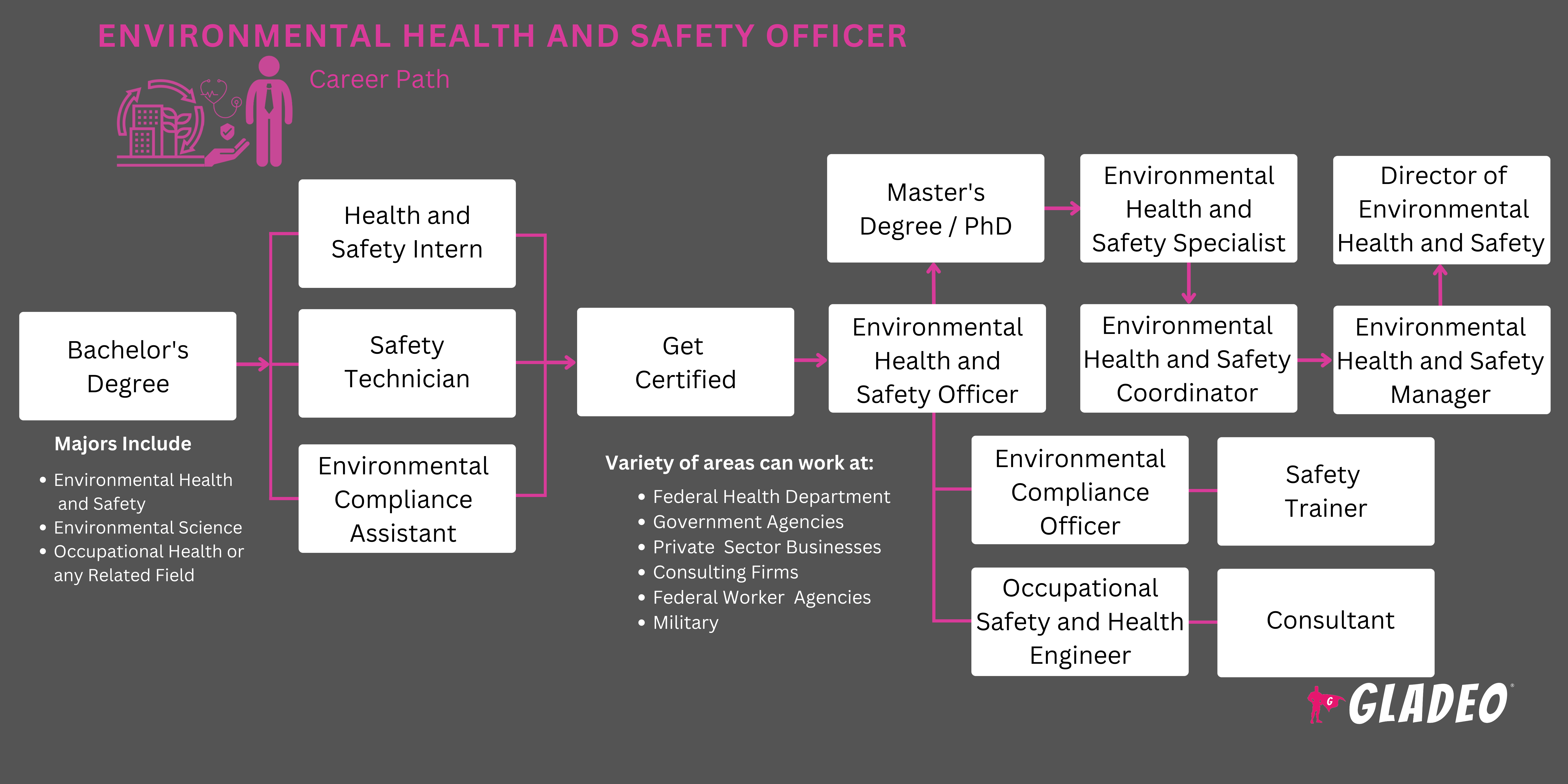Spotlights
Occupational Health and Safety Specialists, Certified Industrial Hygienists (CIH); Chemical Hygiene Officers; Environmental Health and Safety Officers; Environmental, Health, and Safety Officer (EHS Officer); Industrial Hygienists; Industrial Hygienist Consultants; Safety Consultant; Safety Management Consultant; Safety Officer; Safety Specialist
Are you passionate about protecting the environment? Do you want to help keep others safe? If you answered yes to either (or both) of these questions, a career as an Environmental Health and Safety Officer might be right for you!
As an EHS Officer, you'll be the hero behind the scenes safeguarding the environment and health of people in your community—and beyond. Imagine a job where every day brings a new challenge that requires you to combine science and problem-solving skills to assess environmental risks, implement safety protocols to protect workers, and conduct inspections to ensure organizational compliance with regulations.
EHS Officers can also be tagged to conduct safety training, investigate incidents, and work on impactful sustainability projects that contribute to a safer, healthier world. So if you’re ready to make a tangible difference in the lives of others, read on to learn more about this rapidly growing career field!
- Lead efforts in energy conservation and efficiency
- Improve sustainable energy solutions
- Contribute to environmental protection
- Make a positive impact on pollution
Working Schedule
EHS Officers work full-time, occasionally requiring overtime during project deadlines. Travel within the area may be necessary for site evaluations and consultations.
Typical Duties
- Evaluate workplace environments and practices for safety compliance
- Assess workplace risks; identify hazards affecting employees such as fire hazards
- Investigate health complaints and accidents to determine causes and prevent future occurrences
- Analyze incident data for mishap, injury, and hazard trends
- Audit hazardous waste sites and participate in investigations
- Collect samples to analyze for contamination, hazards, toxins, etc.
- Develop/oversee programs for medical monitoring, emergency response, and employee rights
- Manage special programs like noise and ventilation surveys
- Manage inventories of hazardous materials and waste
- Apply for permits applicable to health and safety (i.e., environmental permits, fire safety permits, operating permits, etc.)
- Inspect emergency generators, conduct fire drills, and test elevator systems
- Suggest strategies to safeguard workers against hazardous work practices, processes, or materials
- Suspend activities that endanger worker health or safety
- Work with engineers or physicians to address hazardous conditions
- Prepare hazardous waste samples for transport or storage with appropriate treatment and labeling
- Cooperate with external inspections from the Occupational Safety and Health Administration or similar agencies to find areas for improvement
- Follow up with inspection findings to address issues or violations
Additional Responsibilities
- Communicate applicable information to employees, managers, and contractors
- Apply codes, regulations, laws, and policies related to the health and safety of workers and to ensuring safe facilities and workplace environments
- Ensure proper maintenance of equipment, machinery, and facilities, including fire alarms and sprinklers, HVAC systems, and parking areas
- Provide safety training; demonstrate safety equipment use and wear of personal protective equipment (PPE)
- Offer new employee safety orientation training
- Prepare environmental and safety reports based on assessments and audits
- Participate in sustainability initiatives and meetings
- Advocate for investment in energy-efficient technologies
Soft Skills
- Adaptability
- Analytical
- Collaboration
- Conflict resolution
- Critical thinking
- Decisiveness
- Deductive and inductive reasoning
- Detail-oriented
- Independent
- Integrity
- Interpersonal Skills
- Leadership
- Monitoring
- Negotiation skills
- Organized
- Patience
- Perceptiveness
- Persuasiveness
- Proactive mindset
- Problem-solving
- Risk assessment
- Safety-oriented
- Stress management
- Strong communication skills
- Time management
Technical Skills
- Ability to interpret and apply environmental and safety laws
- Basic understanding of mechanical systems for safety evaluations
- Experience with data analysis, statistical tools, environmental auditing, reporting, compliance and risk management software, project management software, and Geographic Information Systems
- Proficiency in incident investigation and root cause analysis tools
- Familiarity with industrial hygiene equipment and monitoring techniques
- Knowledge of environmental monitoring, sampling techniques, waste management, and hazardous material handling regulations
- Knowledge of workplace safety and health assessment techniques
- Skills in emergency response planning and management
- Skills in developing safety training and education programs
- Construction and infrastructure companies
- Corporate health and safety departments
- Environmental health consulting firms
- Government regulatory agencies
- Healthcare facilities and hospitals
- Industrial and manufacturing plants
- Public and private educational institutions
- Research and development organizations
- Waste management and recycling companies
- Workplace safety and compliance agencies
Environmental Health and Safety (EHS) workers may work extended hours when addressing significant safety incidents or urgent health crises. The job may also require travel to diverse locations, sometimes for prolonged durations, which can affect their personal lives.
EHS workers sometimes face industry resistance or public concerns, requiring them to have strong communication skills. As advocates for workplace safety and environmental stewardship, they play a crucial role in promoting and implementing effective health and safety practices and policies. In addition, they must continuously update their knowledge to stay updated on changing regulations and new technologies.
Current trends in this field include the integration of smart technology and a shift towards renewable energy sources such as solar and wind. The incorporation of AI and machine learning is increasingly crucial for optimizing energy use and enhancing safety protocols.
Other tech trends include the use of electronic reporting systems, working with wearables like smartwatches, and the increase of robotics with cameras and sensors to work around hazardous environments.
These advancements are transforming EHS officers’ roles, because now they may have to manage these technologies while they advocate for sustainable, safe workplace practices.
EHS Officers often show an interest in STEM subjects from an early age. They might have enjoyed activities like crafting models or participating in science fairs.
This early curiosity about how things work, coupled with a concern for environmental issues and the safety of others, may have played a role in guiding them toward a career in EHS.
- EHS Officers typically need a bachelor’s degree in environmental health or science, occupational health, safety engineering, or a related field. Many workers in this field go on to complete a master’s degree
- Students can gain experience by applying for internships related to the environment they want to work in (for example, office environments or industrial work sites)
- Relevant coursework includes classes in:
- Air Quality Management
- Biostatistics
- Chemistry of Hazardous Materials
- Environmental Health
- Epidemiology
- Ergonomics
- Fire Safety Management
- Industrial Safety
- Occupational Health and Safety
- Risk Management and Hazard Control
- Toxicology
- Waste Management and Disposal
- Water Quality and Treatment
- Workplace Safety Compliance
- Specialization options include Hazardous Material Management, Safety Technology, and Environmental Health
- Optional industry certifications include:
- American Society of Safety Professionals - Occupational Hygiene and Safety Technician Certification
- Board for Global EHS Credentialing - Certified Professional Product Steward
- Board of Certification in Professional Ergonomics - Certified Professional Ergonomist
- Board of Certified Safety Professionals - Associate Safety Professional
- Institute of Hazardous Materials Management - Certified Hazardous Materials Practitioner
- National Association of Safety Professionals - Certified Safety Director
- National Board of Public Health Examiners - Certified in Public Health
- National Environmental Health Association - Certified Foodborne Outbreak Investigator
- National Fire Protection Association - Certified Electrical Safety Compliance Professional
- National Institute for Certification in Engineering Technologies - Inspection and Testing of Water-Based Systems
- National Recreation and Park Association - Certified Playground Safety Inspector
- National Registry of Environmental Professionals - Certified Refrigeration Compliance Manager
- Regulatory Affairs Professionals Society - Regulatory Affairs Certification
- Society for Mining, Metallurgy and Exploration - Certified Mine Safety Professional
- World Safety Organization - WSO - Certified Safety Manager (Construction)
- Seek accredited programs in environmental science, occupational health, or safety management
- Prioritize programs with internship and cooperative learning opportunities
- Assess faculty qualifications and achievements. Evaluate the facilities for modern, well-equipped labs and research spaces
- Investigate partnerships with industry and research institutes for enriched learning experiences
- Consider post-graduation outcomes like job placement rates and the strength of the alumni network
- Weigh the cost of tuition against available financial aid and scholarship opportunities
- Decide on the program format (on-campus, online, hybrid) based on personal scheduling needs and learning preferences
- Ask a seasoned Environmental Health and Safety (EHS) Officer to do an informational interview so you can ask questions!
- Watch videos and read online articles related to the career field to familiarize yourself with current environmental health and safety trends
- Popular EHS blogs include:
- ASSP News
- EHS Daily Advisor
- EHS Today
- Environment + Energy Leader
- EPA Perspectives
- GreenBiz
- OSHA Quicktakes
- Safety+Health
- Perillon EHS Management Blog
- Check out job descriptions posted on employment portals, to determine the most current job qualifications and areas of specialization that might interest you
- In high school, load up on biology, chemistry, physics, environmental science, math (especially algebra and statistics), health education, geography/Earth sciences, English, computer science, and government or civics
- Engage in extracurricular activities to gain teamwork, leadership, and project management experience
- Participate in relevant online forums and discussion groups
- Keep track of all your work and academic accomplishments for your resume and college applications

- Upload your resume on job portals like Indeed, SimplyHired, Monster, USAJobs, ZipRecruiter, Velvet Jobs, and Glassdoor, and sign up for alerts
- Review job ads and look for keywords to list on your resume, such as:
- Accident Prevention
- Emergency Response
- Environmental Compliance
- Environmental Management Systems
- EPA Regulations
- Hazardous Materials Management
- Health and Safety Programs
- Incident Investigation
- Industrial Hygiene
- OSHA Standards
- Policy Development
- Risk Assessment
- Safety Audits
- Safety Regulations
- Safety Training
- Workplace Safety
- Review Environmental Health and Safety Officer resume templates and sample interview questions
- Ask your school to connect you with recruiters. Take advantage of chances to intern with EHS-related organizations
- Reach out to your school’s career center to get resume help, do mock interviews, and learn about upcoming job fairs
- Do your research on potential employers, such as:
- Environmental Protection Agency
- Occupational Safety and Health Administration
- Department of Defense
- National Institutes of Health
- Centers for Disease Control and Prevention
- Department of Energy
- National Aeronautics and Space Administration
- United States Department of Agriculture
- Federal Emergency Management Agency
- United States Geological Survey
- During interviews, demonstrate a keen awareness of trends in the industry
- Dress professionally for job interviews
- Ask previous professors and supervisors to write recommendation letters or request their consent (in advance) to list them as references
- Speak with your supervisor or a manager about advancement. Get advice and talk through options.
- Show your willingness to learn, follow procedures, and assume increased responsibilities
- Set the bar high and ensure compliance with regulations to help protect workers, equipment, facilities, work sites, and surrounding areas
- Stay proactive about professional development and taking continuing education courses
- Knock out additional certifications when qualified to do so, like the Board of Certified Safety Professionals - Associate Safety Professional
- If beneficial, consider doing a master’s degree
- Try to gain diverse experience across different workplace environments. After working in different areas, consider specializing in a particular area such as:
- Accident Investigation
- Air Quality Management
- Biological Safety
- Chemical Safety
- Construction Safety
- Emergency Response Planning
- Environmental Compliance
- Ergonomics
- Fire Safety and Prevention
- Hazardous Waste Management
- Industrial Hygiene
- Noise Control and Hearing Conservation
- Occupational Health
- Radiation Safety
- Regulatory Compliance and Auditing
- Risk Assessment and Management
- Safety Engineering
- Sustainability and Environmental Protection
- Water Quality Management
- Workplace Safety Training
- Be active in professional organizations such as OSHA (see our list of Recommended Resources for more information)
- Keep current on changes related to employer policies and local, state, or federal regulations
Websites
- Accreditation Board for Engineering and Technology
- American Academy of Environmental Engineers and Scientists
- American Chemical Society
- American Conference of Governmental Industrial Hygienists
- American Industrial Hygiene Association
- American National Standards Institute
- American Society of Safety Professionals
- Association of Energy Engineers
- Board for Global EHS Credentialing
- Board of Certification in Professional Ergonomics
- Board of Certified Safety Professionals
- Centers for Disease Control and Prevention
- Council of Industrial Engineering
- Department of Defense
- Department of Energy
- ENERGY STAR
- Environmental Protection Agency
- Federal Emergency Management Agency
- Health Physics Society
- Institute of Hazardous Materials Management
- Institution of Engineering and Technology
- International Society for Sustainability Professionals
- International Society of Automation
- Leadership in Energy and Environmental Design (LEED)
- National Aeronautics and Space Administration
- National Association for Environmental Management
- National Association of Safety Professionals
- National Board of Public Health Examiners
- National Council of Examiners for Engineering and Surveying
- National Environmental Health Association
- National Fire Protection Association
- National Institute for Certification in Engineering Technologies
- National Institutes of Health
- National Recreation and Park Association
- National Registry of Environmental Professionals
- National Safety Council
- Occupational Safety and Health Administration
- Regulatory Affairs Professionals Society
- Society for Mining, Metallurgy and Exploration
- U.S. Green Building Council
- United States Department of Agriculture
- United States Geological Survey
- World Safety Organization
Books
- Safety Risk Management: Preventing Injuries, Illnesses, and Environmental Damage, by Fred Fanning
- The Beginner’s Guide to the Environmental, Health and Safety Profession, by Chance Roberts
- Understanding Environmental - Health and Safety: Volume 1, by Alexandru Valentin Sirbu
Environmental Health and Safety (EHS) Officers are crucial to ensuring the safety of employers and worksites. But the job comes with a lot of responsibility, plus occasionally a fair amount of pushback!
There’s a lot of pressure to keep up with and enforce regulatory changes while dealing with stressful situations like workplace accidents. If you’re interested in exploring some related occupations, check out the suggestions below.
- Construction and Building Inspector
- Environmental Compliance Inspector
- Environmental Engineer
- Environmental Engineering Technologist and Technician
- Environmental Scientist and Specialist
- Fire Inspector
- Health and Safety Engineer
- Industrial Engineer
- Mining and Geological Engineer
- Occupational Health and Safety Specialist
- Occupational Health and Safety Technician
- Security Manager
Newsfeed

Featured Jobs

Online Courses and Tools

Annual Salary Expectations
New workers start around $41K. Median pay is $50K per year. Highly experienced workers can earn around $65K.







